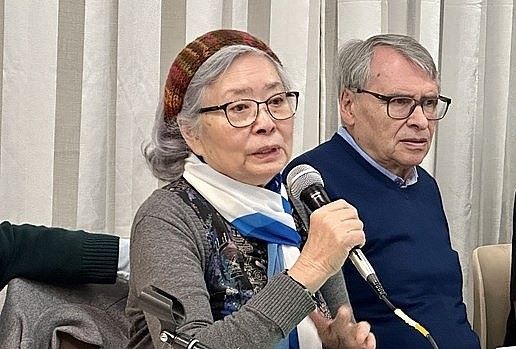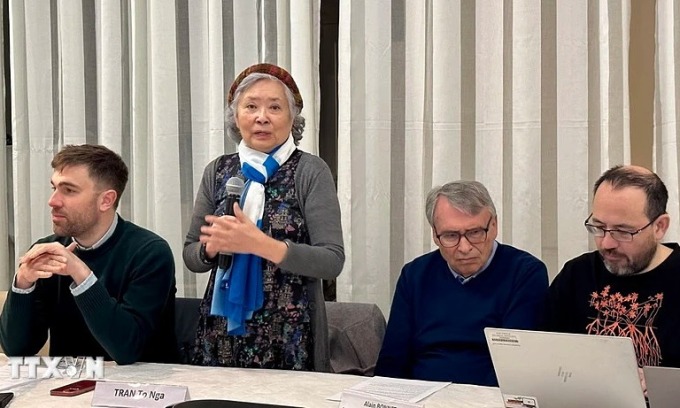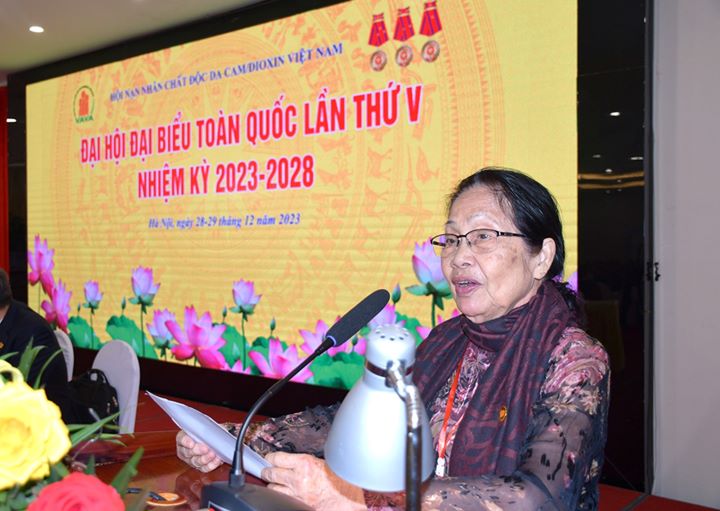* According to other information sources, the Second World War started in 1939.
END OF WORLD WAR II AND THE PROCLAMATION
OF VIETNAMESE INDEPENDENCE
In August 1945, the Second World War ended with the capitulation of Japan, but Japanese troops continued to occupy Vietnam. In order to disarm them and to send them home, the Allies (Roosevelt, Churchill and Stalin) had decided before the end of the war, that north of the 16th parallel, this task would be given to Chiang Kai Shek and, south of it, to the British. As a result, bands of wretched Kuomintang troops swooped down on Bac Bo (formerly Tonkin) and the north of Trung Bo (formerly Annam) and for several months systematically plundered this country just emerging from famine. In September, 1945, the British arrived in the south, but rapidly gave way to the first Free French forces which had decided to re-establish French authority over their former colony. The situation was not, however, as it had been before the war. At the call of Vietminh led by Ho Chi Minh, the popular movement of the August Revolution (1945) handed over power throughout the country to the revolutionary forces and on 2 September 1945, Ho Chi Minh proclaimed the independence of Vietnam and the founding of the Democratic Republic of Vietnam (DRV). After almost a century of colonial rule and the ordeal of 5 years of war, the Vietnamese people could at last hope to enter on an era of peace and freedom.
THE INDOCHINA WAR
Nothing, however, came of it. In autumn 1945, French troops wanting to re-establish French domination over Nam Bo (formerly Cochin China) collided with the young revolutionary power and the war began afresh. The DRV, however, offered to negotiate in order to secure the recognition of an independent Vietnam within the French Union. Initially, in the context of the negotiations which had begun, French troops under the command of General Leclerc were allowed to return to Tonkin and the Agreement of 6 March 1946 signed by Leclerc and Ho Chi Minh, opened the way to a general negotiated solution to be completed by a conference at Fontainebleau in the summer of 1946. In France, however, forces wishing to see the re-establishment of the colonial status quo and refusing, in particular, to recognize Cochin China as an integral part of Vietnam, brought about the failure of that conference. In November 1946, the French fleet bombarded Haiphong, causing thousands of deaths, and in December fighting broke out in Hanoi. The Indochina war had begun.
This war was to last almost seven years, until July 1954. In 1950, after the battle of the borders which enabled Vietnam to receive help from the People's Republic of China (which had defeated Chiang Kai Shek in October 1949) and the USSR, it became obvious that the French Union troops could not win. France, which had emerged weakened from the Second World War, could not shoulder the very heavy human and financial burden of a conflict which public opinion did not support. It had, moreover, sided with the U.S in the "cold war" against the socialist countries, in which the U.S and its allies were opposed to the USSR and its allies. The conflict with Vietnam directed by a communist party became part of the worldwide .conflict between the two opposing camps. Successive French governments, which refused to negotiate with Ho Chi Minh, turned to their American ally, requesting financial aid on an increasingly enormous scale; in 1954, the U.S financed the "French" war to the tune of 80%. The Vietnamese victory of Dien Bien Phu (7 May 1954) forced France to make peace at the Geneva conference. The U.S, however, did not sign the Geneva Agreements (20 July 1954), which recognized the independence of the whole of Vietnam, and set about preventing their implementation.
NON-IMPLEMENTATION OF THE GENEVA AGREEMENTS
During the 1950s and 1960s, the entire world, which had been plunged into the "cold war", was living under an extreme tension. Like Vietnam, Germany and Korea each was divided into two hostile States. Major crises (the Berlin Airlift, the 1962 Cuban missile crisis, etc.) threatened to unleash a nuclear war. World opinion was mobilized against this danger (Stockholm Appeal). For Vietnam, the end of the French war did not mean peace.
The end of the Indochina war was to result in disarmament of the armed forces which were tn contact with one another throughout the country. It had therefore been decided that these troops would be relocated, those of the DRV to the north, those of France and its Vietnamese auxiliaries to the south, the temporary line separating the two disarmament zones passing along the 17th parallel. Two years later, general elections were to be held throughout the country in order to give Vietnam a single government. In fact, as a result of the non-implementation of the Geneva Agreements, Vietnam would spend 21 years cut in two.
In fact, France, which was legally one of the guarantors of these agreements, very quickly handed its responsibility for the southern part of Vietnam to the U.S (by the Ely- Collins agreements concluded on 13 December 1954). Ngo Dinh Diem was put in power in Saigon and with American support set about getting rid of as many French as possible. In 1956, he refused to hold the planned elections, which, as the whole world knew, would favor Ho Chi Minh, and so prevented the reunification of the country. As protests by the population, which desired reunifications, spread, he tightened his dictatorship, the U.S providing him with ever greater financial support and sending him "advisors” to set up an army. The opposition, initially peaceful, faced an increasingly savage repression, which by the end of 1959 had become an armed struggle, led from 20 December 1960 onward by the NLF (National Liberation Front of South Vietnam). Faced with this growing pressure, the Saigon regime proved increasingly incompetent. In order to mitigate successive setbacks of this fight carried on against the national will of the Vietnamese people, the U.S had become more and more involved, a fact already often recognized by the international press, including the American.
THE AMERICAN WAR
So began the escalation of the American war, which was to end in complete disaster on 30 April 1975. This escalation comprised several stages, each ending in a setback and leading to the next, accompanied on each occasion by an intensification of the war and the increasing involvement of the U.S.
The first stage, beginning in 1961 during the Kennedy presidency, was the so-called "special war". The purpose was to obtain the "pacification" of South Vietnam. The plan entailed three main parts: a considerable increase in financial aid, in particular for developing the Saigon-controlled army, the deportation of peasants in order to concentrate them in "fortified villages", painted by propaganda as "zones of prosperity" but which were in fact closed and monitored areas designed to prevent the help being given by the population to Zu Kit (Du Kich), the guerrillas and lastly, substantial increase of the number of American "advisers", more and more involved in the fighting. In fact, with the creation of the US Military Assistance Command in February 1962, the U.S had assumed the management of what had become a war.
By 1963, however, the failure of this strategy had become obvious. On the political level, Ngo Dinh Diem was no longer giving satisfaction and was accordingly removed. In Saigon, coups d'etat had succeeded one another, with different generals successively coming into power, but without the general situation ceasing to deteriorate. Bernard Fall wrote: "If Mickey Mouse assumed power in Saigon, nobody would notice". On the military level, the NLF had won significant victories (such as the victory of Ap Bac). The Americans were no longer facing a "rebellion", but large and structured armed forces, which had already liberated huge areas of the country.
In 1965, during the Johnson presidency, two further steps were taken. The U.S began bombing the DRV north of the 17* parallel, taking the war up to the Chinese border and, in addition, directly involving their units in the South.
Air bombardment of the North
The attack on the North was triggered at the beginning of August 1964 by the so-called "Gulf of Tonkin" affair, with the U.S claiming that some of their ships had been attacked by Vietnamese patrol boats. The American air force bombed the territory beyond the 17th parallel and from 7 February 1965, the bombing had become a daily event, increasing in intensity and horror (napalm, phosphorus and the terrible anti-personnel bombs called "bullet bombs"). These attacks, initially limited to the area south of the 20th parallel, were next extended to the entire territory of the DRV. Many towns such as Phu Ly, Nam Dinh and others were razed completely to the ground. Haiphong was badly damaged and, in December 1972, even Hanoi was attacked several times by B52 raids. In the countryside, thousands of villages were destroyed, the aircraft aiming to stop all traffic, in particular in the mountains of Truong Son (the Annam Cordilliera), in order to cut the famous "Ho Chi Minh trail" which linked the DRV to the guerrillas in the South. The civilian victims numbered many tens of thousands, without however, the population giving in to the terror or interrupting the links with the South.
The war in the South
American troops had begun arriving in the South from March 1965 onwards. From numbering a few thousand in the beginning, they had grown to 550,000 men, comprising, apart from American soldiers, contingents of Australians, South Koreans and so on. This invasion tragically disrupted the social and economic life of the South: population migration, particularly from the High Plateaus (Central Highlands), inflated the population of cities, primarily that of Saigon, which rose from half a million to over 5 million inhabitants, with prostitution, drugs and the like complementing the drafting of hundreds of thousands of men. The firepower on land and in the air was gigantic, but it was poorly adapted to the type of fighting practiced by the NLF, which held forest and jungle areas. In order to dislodge them, the U.S tried to defoliate trees and from 1961, began to spray chemical agents over huge areas, the best-known being Agent Orange, the long-term effects of which were to prove disastrous. Meanwhile, NLF successes continued. The NLF was in fact kept supplied and informed by the population and increasingly reinforced by the DRV in men and arms, the DRV in turn being powerfully supported by the socialist countries, principally China and the USSR.
Like France twenty years earlier, the U.S sustained many military and political setbacks. The American forces were defeated in major battles such as that of Khe San (Khe Sanh). On the political level, American aggression was increasingly condemned by world opinion, especially in France and the American population itself had become increasingly less supportive. On the diplomatic level, the American involvement began to be increasingly criticized by numerous powers, in particular by France (speech by General De Gaulle at Phnom Penh on 1 September 1966)
Paris Conference and Agreement - End of the war
In 1968, President Johnson had to agree to opening negotiations with the DRV without prior conditions. Discussions then began in Paris and they would last for 5 years. On the American side, the conference was attended by representatives of the last Saigon dictator, Nguyen Van Thieu and, on the DRV side, by representatives of NLF which in June 1969 became the PRG (Provisional Revolutionary Government of South Vietnam). At the same time in 1969, the U.S extended the war to Cambodia, but simultaneously announced the withdrawal of its troops. Finally, on 21 January 1973, the Paris Agreements were signed.
This however still did not mean peace. In fact, although the bombing in the North had ceased, the situation in the South remained belligerent and confused. In contrast with the solution reached in Geneva in 1954, the opposing forces were not placed in two separate zones but remained in the positions which they occupied on the ground at the time of the Agreement. The country was accordingly split into a jumble of numerous zones of varying sizes (a "leopard skin"). Neither Thieu, nor the Americans gave up their desire to dominate the whole of the South. The Americans, who had gradually withdrawn almost all their land forces, left behind their enormous stocks of weapons, organized air cover and continued to finance the Saigon dictator. Skirmishes proliferated Very rapidly and in a few months the war had begun afresh. The Americans thought that the abundant army, which they had given to the Saigon power, would enable it to triumph. But nothing came of it. In view of the obvious breach of the Paris Agreements, Vietnam found itself at war and the DRV army entered the fight on the side of the PRG forces. In the spring of 1975, Thieu's troops collapsed and on 30 April 1975, the DRV armored columns entered Saigon. The Saigon regime disappeared in the general stampede and Vietnam had in fact been reunited. The war had ended and in the spring of 1976, general elections were at last held and a National Assembly was elected. It in turn, proclaimed the Socialist Republic of Vietnam, which is the present State of Vietnam.
The Terrible Sequel to the War
Nevertheless, the American war together with the French war left deep wounds: 3 million dead and between 2 and 5 million wounded and maimed. During the American war, Vietnam, two-thirds the size of France, was subjected to a weight of bombs greater than the total weight of bombs which had fallen on the whole of Europe during the Second World War. In the North, air bombardment, using every weapon of terror, razed towns and destroyed the infrastructure. In the South, the intensity of the fighting affected the entire territory, causing ravages among the population, including the destruction of leaders during the "Phoenix Operation", which claimed tens of thousands of victims. Lastly, in order to dislodge NLF soldiers hiding in the forests, the U.S sprayed defoliants, particularly Agent Orange, over 2,500,000 hectares, which not only destroyed the vegetation, contaminated the soil and killed men, women and children, but extended their devastating effect until the present, causing monstrous births, even into the third generation.
By 2005, the war in Vietnam had been over for thirty years. At the price of enormous efforts, the people of Vietnam had overcome the material disasters of decades of war waged against it. But its population is still suffering in the flesh the atrocious sequel of the spraying of toxic products of which the American army had been guilty.
Charles Foumiau, historian Honorary chairman of the AAFV
BIBLIOGRAPHICAL REFERENCES
Chaffard (G.), 1969, Les deux guerres du Vietnam. De Valluy à Westmoreland, La Table Ronde, Paris.
Dalloz (J.), 1992, La guerre d'lndochine, 1945-1954, Le Seuil, Coll. Points-Histoire, Paris, 2eme edition.
Devillers (P.), 1952, Histoire du Vietnam de 1940 d 1952, Le Seuil, Paris, 480 p.
Fourniau (C.), 2003, Le Vietnam que j'ai vu, Les Indes savantes, Paris, 254 p.
Goscha (C.), de Treglode (B.), eds., 2004, Naissance d'un Etat-Parti. Le Vietnam depuis 1945, Les Indes savantes, Paris.
Kamow (S.), 1984, Vietnam, Presses de la Cite, Paris.
Ruscio (A.), 1992, La guerre frangaise d'lndochine (1945- 1954), Ed. Complexe, Coll. La memoire du siecle, Bruxelles.



_thumb_720.jpg)








_thumb_720.jpg)



















Comment